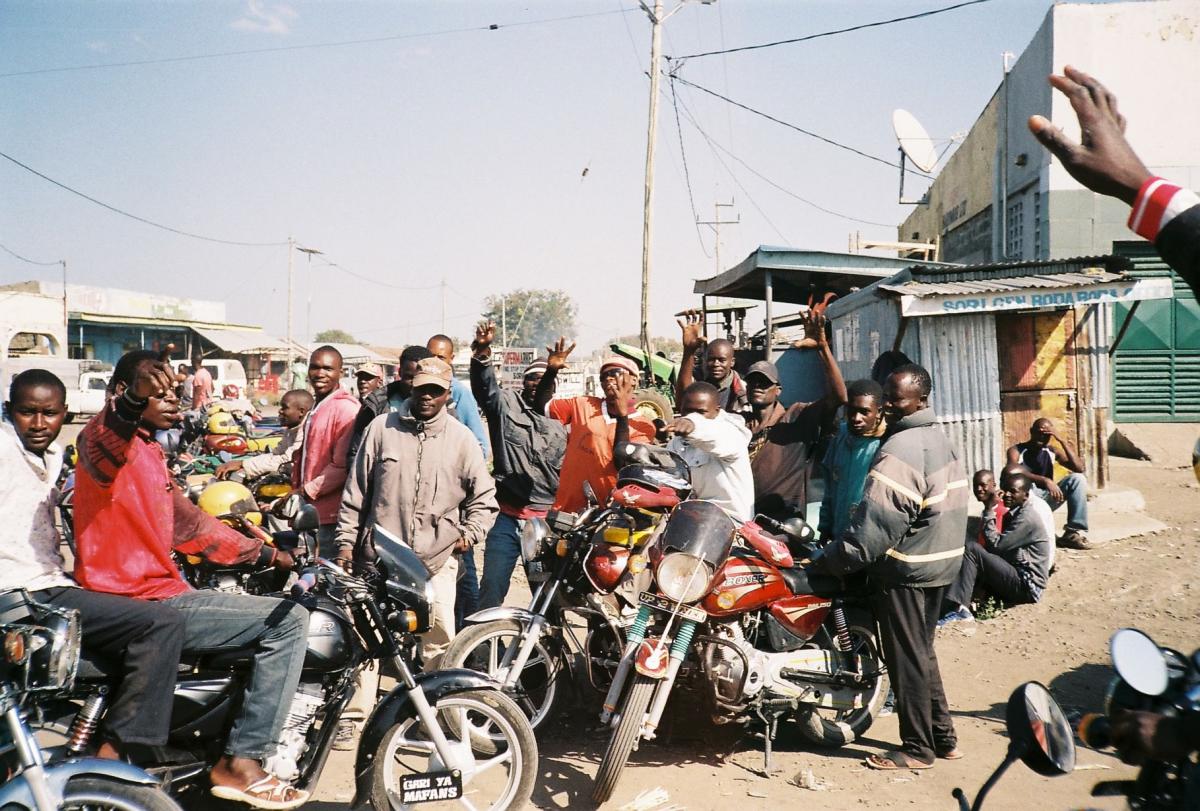
Benga: From the Streets of Nairobi
Benga is – besides hip hop – probably Kenyas most popular music genre. Alan Marzo, Olivier Duport and Carl Åhnebrink went to Nairobi to find out more about its social reality. Read their report accompanying the launch of their magazine Flee.
Landing at 3 am in Nairobi, a city one of us knows very well for having lived there for years, our mood was, at the image of the weather: foggy. Naturally, the inconvenience of trying to find a cab with four wheels which does not charge the full «Mzungu» (term used in East Africa to refer to people of European descent) price is always annoying, but what concerned us the most was the event we had to organize to officially launch our project in Kenya. In fact, while we were convinced of the quality and the serious of our work of documentation and artistic approach, we were not sure of the kind of impact this project could have in Nairobi and who would actually attend the event. After two years of attempting to document a Kenyan iconic music genre, creating links with contemporary music producers, working with Kenyan artists and journalists, graphic designers and illustrators, it was time to face a reality-check on a music genre that is more than 50 years old and on our project more generally.
Reality Check
Indeed, for Benga, everything started half a century ago, in the late 1960ies. In this era, urbanisation progressed very rapidly in Kenya, including the shores of lake Victoria. There, assisted by talented musicians who had learnt to master their instruments in the British military bands and inspired by the traditional ritual Luo music of their ancestors, a new generation of Kenyan musicians was growing. With John Ogara, Colella Mazee, D.O. Misiani, Ochieng Nelly and many more, they would quickly reach a particular music refinement and become the forefathers of a new music genre: Benga was born.
As the genre evolved, absorbing the spirit of traveling musicians inspired by Congolese and Tanzanian Rumba, it quickly became the voice of rural masses in Kisumu, before conquering the urban centres of the entire country. Originally characterized by songs focusing on inequalities and injustice with humour and irony, the genre slowly developed into a well spread popular music style, enabling different Kenyan communities throughout the country to sing about their daily lives strengthening the national identity of an embryonic nation. In this context, for two «Wasungus» like us traveling to Kenya to present their project, and despite our good faith, the limited understanding of the Kenyan cultural nuances and politically loaded episodes colouring the country’s history were the subject of a certain fear, in the framework of this pursued reality-check.
The event in Nairobi started, and we came to face the challenges we expected very quickly. Having focused our work on documenting and revisiting the music genre, working with local journalists, Kenyan and international artists as well as technicians, we had elapsed to do an exhausting mapping of the existing private and institutional actors evolving in the sector. This was made clear by the first reaction of some Kenyan labels and other associations focusing on Kenyan music, which was to consider Flee as a strange and new competitor to their own practice. In a country where institutional funding is limited and where the music industry has suffered from decades of corruption and disorganization, the concept of «complementarity» and «expanding the pie» are often preceded by the feeling of «competition over».

Three Europeans in Africa
It appears that our naïve approach nourished by a conviction that our project could only benefit all the actors involved produced some mistrust among a portion of our audience that led to critical questions towards Flee. Paradoxically, this immense challenge turned into a fascinating opportunity to self-scrutinize our own work and clarify our position on multiple problematic and sensitive questions. Among those difficult questions, legitimacy appeared to remain the central problematic theme. In other words, is it possible for three Europeans to become an amplifier of local Kenyan voices and ensure positive returns for the communities, while avoiding a biased ethnocentrism?
Our answer became «Nyes». In fact, while the ethnocentric approach can’t be fully mitigated and that, as foreigners and products of different socio-economic landscapes, we might have difficulties in grasping the essence of such a specific music genre, working with local journalists and artists allowed us to develop a transparent and honest narrative. Furthermore, it is worth noting that Benga responds to very local and rural dynamics, and often takes place among particular socio-linguistic communities. In this context, the above-mentioned challenges would probably not be exclusively felt by non-Kenyans. They could probably be faced as much by the new generations of urban Nairobians, as well as Kenyans living in different regions, or any diaspora throughout the world. Eager to avoid an intellectual straightjacket promoting inaction, we argued in favour of a supported validity of our approach, which is based on the possibility of mitigating methodological and critical challenges by keeping a continuous transparency.
Of course, in an increasingly globalized world, those types of critical questions will become more and more complex, in a dynamic where Internet has connected the new generations from different cultural backgrounds and horizons as never before. On the other hand, it is important to similarly keep in mind that the increasing interconnection of people from around the world has not waited for the inventions of Bill Gates and Steve Jobs to operate on the music industry.
Playing the Old, Facing the New
Indeed, present that night, Kabila Kabanze (known as Evany), Lutulu Kanicky, and Kalenga Nzaazi, members of the iconic Congolese band l’Orchestre les Mangelepa, are a symbol of the fusion characterizing the Kenyan music scene. Arrived in Nairobi more than 30 years ago, the band has never left the city and strongly contributed to shape the character and identity of Kenyan music, including Benga. Recognizing this fact, Emmanuel Mwendwa, Kenyan music journalist and panelist during the launch, encouraged the audience to go beyond the essentialization of Kenyan music and acknowledge that «Benga itself had several influences from many places, including Zaire, Tanzania, and Uganda (and that) artist influenced one another», concluding that the phenomenon was a «good thing».
Concluding the event, Kenyan Afro-pop and experimental musician Labdi Ommes, reappropriating herself the «Orutu» (traditional one-stringed fiddle that originated in societies of western Kenya, especially amongst the Luo community) in a very contemporary manner, reassured us in our artistic journey. Singing alone with the traditional violin, she does not fear to merge and mix genres, traditions and eras, and create something new, which is definitely hers. In that regard, we quickly came to the conclusion that doing our so-called reality-check was actually irrelevant: what matters is to accept that Benga encompasses various and fluid realities. Those realities have been forged by different generations of musicians and artists who came from different countries, bringing with them several inspirations, all of them eager to respect and absorb the heritage of Benga, before attempting to give the genre a new life under their own creative process. In the end, this echoes very positively with the Flee approach and its manifesto which «endeavours to document and enhance hybrid cultures, while asking contemporary artists to revisit objects from various periods and genres with the ambition to transcend the trend of unproductive nostalgia which purely romanticises the past».
Flee Magazine is a cultural engineering platform dedicated to the documentation of hybrid cultures. Functioning as a record label, publishing house and exhibition organizer, it was founded by Alan Marzo, Olivier Duport and Carl Åhnebrink. For each issue, Flee will release a vinyl record along with a printed magazine helping its audience to fully grasp the essence of the movements highlighted.
In the end of 2017, Flee released a silk-screened printed magazine and a vinyl record shedding a new light on Benga music, an iconic genre from East- Africa. With a work of documentation and successful hybrid electronic musicians revisiting this highly rhythmic music, the project ensures the vibrant traditional roots of the genre interact with a contemporary approach. In October 2017, it released its first issue: Benga – a Signature Genre from Kenya. After a successful launch of the project in Berlin, the collective went back to Kenya to present Flee 001, an opportunity to do a proper reality check in the home country of Benga as to look back on their own contradictions. The repress will be available from April 9 at www.fleeproject.com
Biography
Links
Published on April 27, 2018
Last updated on June 27, 2023
Topics
From the music format «78 rpm», the melancholic echoes of a dubbed out rave night in London, and parodic mockings of «perfect house wifes» by female Nigerian pop musicians.
From westernized hip hop in Bhutan to the instrumentalization of «lusofonia» by Portuguese cultural politics.


